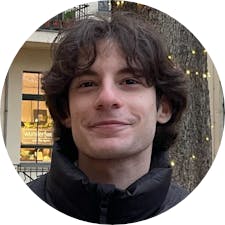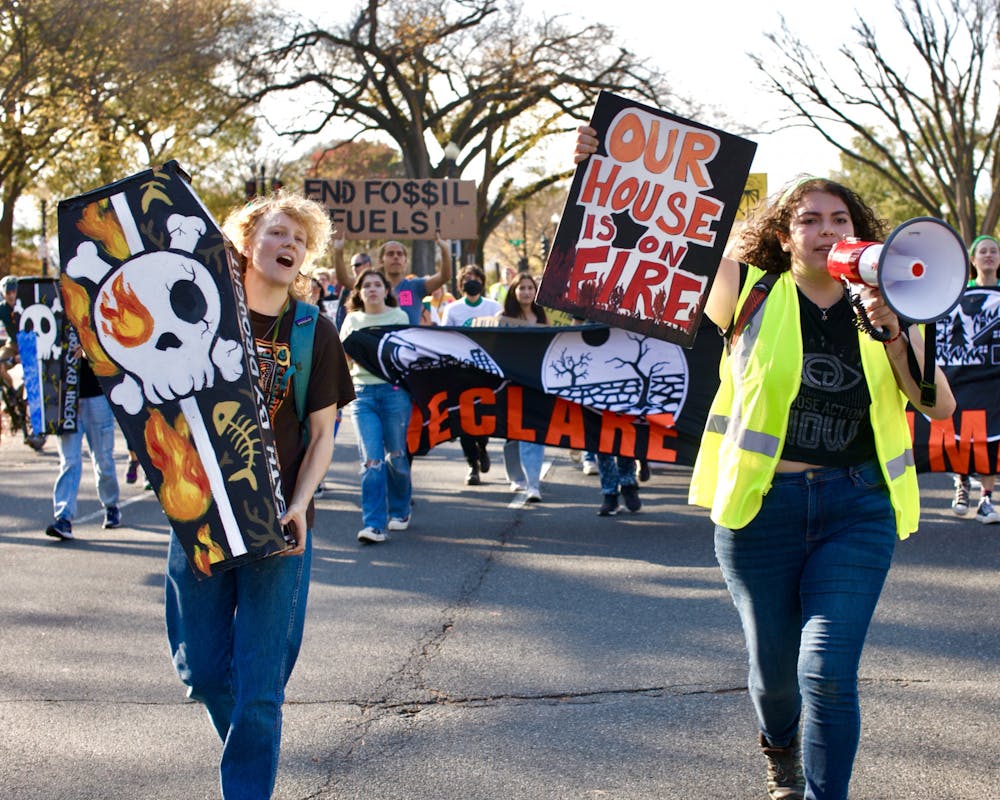On Saturday afternoon, 17 members of Sunrise Brown joined activists from eight other groups from across the country — including Extinction Rebellion DC, Code Pink: Women for Peace and Native Youth Leadership Alliance — to gather on the steps of the Lincoln Memorial holding hand-painted signs and demand immediate action against climate change.
The protest was planned by Earth Guardians, an international organization that rallies youth leaders, activists and artists on the front lines of climate activism. This was part of a larger global Day of Action campaign, which called on activist groups across several countries to participate in climate action demonstrations.
The campaign was scheduled to coincide with the 27th Conference of Parties of the United Nations Framework Convention on Climate Change. Taking place from Nov. 6 to 18 in Sharm el-Sheikh, Egypt, COP27 aims to “deliver action on an array of issues critical to tackling the climate emergency,” according to the United Nations website.
The Day of Action “campaign is about how there needs to be tangible action” from the COP events that have been going on for the past 27 years, said Lizzy Duke-Moe ’26, actions task force lead for Sunrise Brown and one of the students involved in planning the Washington, D.C., protest with Earth Guardians.
The Washington, D.C. protest was designed “to apply pressure to the international community, and especially the United States, to continue to focus on climate solutions and prove that people at home are still paying attention,” said Isaac Slevin ’25, chapter coordinator for Sunrise Brown. “We want to prove that students care, (that) we’re watching and (that) we want more than they’re providing us.”
“Governments really are not doing enough. They need to change and take accountability for their complacency in the fossil fuel industry and (inadequate) policy,” said Isabella Garo ’24, co-founder of Sunrise Brown. “We were hoping that this protest could serve as a signal to (the United States) … that there is a big presence of young people that are going to hold their government accountable.”
The protest began at 12:30 p.m. on the Lincoln Memorial Steps, where representatives from different activist groups performed speeches, songs and various other demonstrations. Duke-Moe did a reading of “The Salmon People,” a poem she wrote with a fellow activist that strings together Nordic folk stories with Lummi Nation creation stories. Duke-Moe first wrote the poem for Red Road to DC, a campaign led by the House of Tears Carvers of the Lummi Nation which transported a 25-foot totem pole from Washington State to Washington, D.C. to advocate for the protection of sacred tribal lands.
Following these demonstrations, the protestors marched to the U.S. Capitol building along Constitution Street, which was blocked off for the event.
When organizing Sunrise Brown’s involvement in the protest, group leaders were dedicated to ensuring that everyone who had the time to go to Washington, D.C. would not be hindered by financial access to transportation or accommodations, according to Slevin.
But because the protest was planned last-minute, Sunrise Brown had to “circumvent certain channels on campus” when trying to acquire funding, Garo explained. Instead of going through the Undergraduate Finance Board, Duke-Moe led a grant application initiative and the group managed to secure a $3,500 grant from the Future Coalition’s Youth Direction Action Fund. The Future Coalition is a national network that aims to support queer and BIPOC youth activists.
Using the funds from Future Coalition, Sunrise Brown paid for every member’s transportation and food while two group members from Washington, D.C. housed attendees, Slevin said.
“We got to provide this opportunity to people with no cost barrier,” Slevin said. “It was just a question of whether people cared about the cause. That’s an opportunity that we’re going to continue to provide” to students.
Garo said that she was grateful that during her first time in Washington, D.C. she was able to fight for a cause she cared about. “I got to meet some incredible people from all walks of life,” she said. “I was very honored to hear their stories.”
“It was an amazing experience,” said Juliana Esteban ’26, who was one of the many first-years in attendance at the protest. Esteban had never previously attended a protest of this size. “Hearing people’s speeches, … you can just (hear) the passion in their voice. That was so inspiring.” For Esteban, seeing the power of an organized collective made a difference in the way she views activism and environmentalism.
Artistic demonstrations played a major role in the protest, according to Duke-Moe, who said she believes that bridging art and activism is the best way to reach broader audiences. Protesters painted a mural on the street that depicted a hand making a peace sign and holding the globe, with the slogan “stop wars, save climate” written around it.
Before heading to Washington, D.C., Sunrise Brown held art-making nights in the Urban Environmental Lab where students could come together to make creative pieces for the demonstration, according to Slevin. Several students constructed two wooden coffins cut from scrap wood from the Brown Design Workshop and painted them to read “death by fire, death by drought” and “death by storm,” representing the climate disasters that currently affect the country.
“Sunrise Brown and broader climate coalitions should be spaces where people feel like they belong, like whatever they contribute is valuable … and feel that they can have fun in the movement,” Slevin said. “We want people to be part of (Sunrise Brown) because it’s fun, because it’s empowering and because we all support what (everyone) can contribute” to the cause.
Esteban was also given the opportunity to document the protest through video and audio recordings in what she described as her first serious video project. In a video shared on the Sunrise Brown Instagram page, Esteban aimed to capture the “energy of the protest” by focusing on the demeanor and expressions of people who were marching, she said.
Sunrise Brown “wants to send a message that has broad appeal and that a lot of people can relate to,” Garo said. “For some people, that’s chanting and a march, and for others that’s looking at a piece of art on the street and listening to music.”
“I really appreciate the diversity in how we communicated this message,” she added. “I’ve never been part of a protest that was so diverse in its communication.”
These art-making nights also allowed University students that could not attend the protest in Washington, D.C. to participate in the demonstration in some capacity, Duke-Moe said.
Sunrise Brown “is trying to engage in climate justice above all else,” Slevin said. “Not just climate protection for the nebulous concept of saving the environment, but recognizing all of the people whose lives are being affected by climate change.”
“That means that in our activist work, we want to be aware of the different perspectives that people are coming from,” he added.
Garo recalled a sense of overwhelming “teamwork” both in the three-week planning period leading up to the protest and during the actual demonstration in Washington, D.C.
“It was really empowering to build community and build solidarity. Sometimes it feels like you’re yelling into a void” with activism work, Slevin said. “But to travel with 16 students at Brown who were willing to spend their weekend rallying for climate justice is really incredible.”
“When we were rallying and coming together as a group Saturday morning, … it felt like I was back home surrounded by all of these activists,” Duke-Moe said. “Even though we were marching about something so horrible, everyone just couldn’t stop smiling and chanting and singing. That energy is what Sunrise Brown is going to bring to campus.”

Alex Nadirashvili was the managing editor of multimedia and social media for The Brown Daily Herald's 133rd Editorial Board. As a former University News editor, he covered faculty, higher education and student life, though his proudest legacy is The Brown Daily Herald TikTok account.





